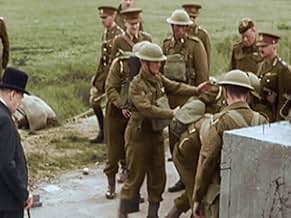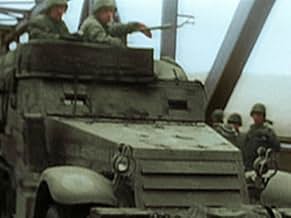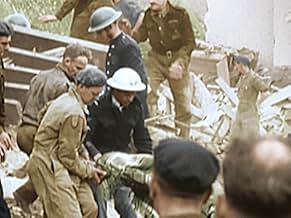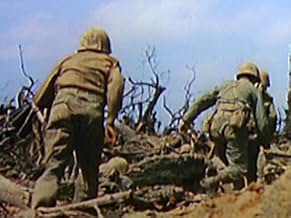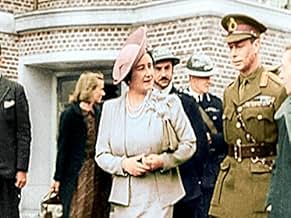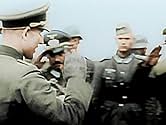CALIFICACIÓN DE IMDb
8.7/10
7.8 k
TU CALIFICACIÓN
Relata los eventos de la Segunda Guerra Mundial en color.Relata los eventos de la Segunda Guerra Mundial en color.Relata los eventos de la Segunda Guerra Mundial en color.
Explorar episodios
Opiniones destacadas
At 13 episodes of 51 minutes each, you can imagine you get a good overview of the major events of the war. For someone who is born towards the end of 20th Century, and only heard and read bits and pieces, this was a great way to connect the dots and get a total overview of those years which shaped the world even to this day. Does it feel a bit biased towards the allied forces? It does feel at times, but not too much to lose it's authenticity. I wished however to also describe how war was experienced by the civilians, what they had to go through, and especially, a dedicated episode to the atrocities against the Jewish population. It was overwhelming at times, on one hand because of the horrors shown on screen, and the other because of the continuous battle scenes, which in case of binge watching is sure to give one a headache. However, it is a must see for everyone, as it's very important to know our past, to avoid repeating the same mistakes.
Documentary series on World War 2. Covers each of the major campaigns in detail and uses colourised archival footage.
An excellent documentary series. I've watched all the best WW2 documentaries, including the pinnacle of the genre, The World at War, and this is among the best.
Cynically I thought the series' selling point would be the fact that the footage is colourised and that it would rely heavily on this feature to get by. I needn't have worried: the series does not rest on the fact that it has colourised footage and other than the title of the series, no attention is drawn to this.
It's simply a great all-round documentary series: good detail without being tedious, great, relevant video material, superb, stirring, gravitas-filled narration by Robert Powell. It doesn't quite measure up to The World at War but nothing does.
An excellent documentary series. I've watched all the best WW2 documentaries, including the pinnacle of the genre, The World at War, and this is among the best.
Cynically I thought the series' selling point would be the fact that the footage is colourised and that it would rely heavily on this feature to get by. I needn't have worried: the series does not rest on the fact that it has colourised footage and other than the title of the series, no attention is drawn to this.
It's simply a great all-round documentary series: good detail without being tedious, great, relevant video material, superb, stirring, gravitas-filled narration by Robert Powell. It doesn't quite measure up to The World at War but nothing does.
A cursory review of a series which is quite the opposite; WWII In Color is an awe-inspiring look into the second world war which provides the viewer with a comprehensive understanding of the events of WWII through narration and colorized video. This series ― narrated by Robert Powell ― covers the entirety of WWII from precursory events which would kick-start the war, to Japan's surrender and the beginning of the Cold War. In an already academically intense genre, World War II in HD Color not only meets high expectations, but exceeds them entirely. Easy to pick up, this well-researched series condenses the war into a few episode's worth of educational content. Robert Powell's delivery in narrating vital moments in the war is perfectly done as his talent shows in such a way that the viewer will surely feel the emotion behind each and every catastrophic event. Furthermore, the footage is truly moving accompanied by the expert narration which includes: devastating footage of a holocaust concentration camp, adrenaline-filled battles, convening of world leaders and more, accompanied by geographic animations, the colorized footage is sure to leave an impact. In essence, this 5 star, extremely detailed and historically accurate series will ensure you come away with nothing less than a complete understanding of many events in the Eastern and Western Fronts, the North African Campaign, and the Pacific War via colorized video and emotionally moving narration.
The segment "The Island War" treats the liberation of the Phillipines as an unnecessary and overly costly (and therefore ill-advised) operation. However, that totally fails to recognize that in war, there are both military and political concerns and that grand strategy requires the consideration of both. War is, quite simply, foreign policy pursued by other means. Therefore, foreign policy has to be considered in the strategy of the war.
Because the USA had a commitment to the Phillipine people as a protectorate, it was politically necessary to return as soon as was humanly possible. MacArthur may have left, but Phillipine guerrillas had been fighting and dying against the Japanese with US supplies and coordination from the very beginning. To ignore a chance to liberate the Phillipines would have been no different than leaving Paris in German hands while liberating Holland and Belgium. It was politically imperative! Likewise, the episode maintained that the "Northern arm" of the Japanese pincer had "only pretended to retreat and under cover of darkness had reversed course..." both Japanese and American accounts, much closer to the event when interviews with actual participants were available, indicated that the Northern force actually intended to retreat and only reversed course following critical comments from the high command.
Halsey had every reason to have believed that the Northern force was less a threat than Ozawa's aircraft carrier force which had just been spotted. Every previous naval victory in WWII had come at the hands of the aircraft carriers, NOT the battleships. When confronted by two enemies... one with a knife and the other with a machine gun, only the fool deals with the knife first! There were American POWs held in the Phillipines. Many were saved during this operation. The civilian casualties were indeed great, but that was the choice of the Japanese occupiers and how many would've died, either of brutality or starvation had the islands been bypassed? The further we get from WWII, the less accurate do the "documentaries" become. You can tell a good story with the films, but unless you have spent years studying the contemporary histories, from both sides... false conclusions will run rampant. As the last of the participants pass from this life, there can be no more "factual" accounts. The eyewitnesses are silent now. Don't just watch, READ, READ, READ the books that were published before 1960.
Because the USA had a commitment to the Phillipine people as a protectorate, it was politically necessary to return as soon as was humanly possible. MacArthur may have left, but Phillipine guerrillas had been fighting and dying against the Japanese with US supplies and coordination from the very beginning. To ignore a chance to liberate the Phillipines would have been no different than leaving Paris in German hands while liberating Holland and Belgium. It was politically imperative! Likewise, the episode maintained that the "Northern arm" of the Japanese pincer had "only pretended to retreat and under cover of darkness had reversed course..." both Japanese and American accounts, much closer to the event when interviews with actual participants were available, indicated that the Northern force actually intended to retreat and only reversed course following critical comments from the high command.
Halsey had every reason to have believed that the Northern force was less a threat than Ozawa's aircraft carrier force which had just been spotted. Every previous naval victory in WWII had come at the hands of the aircraft carriers, NOT the battleships. When confronted by two enemies... one with a knife and the other with a machine gun, only the fool deals with the knife first! There were American POWs held in the Phillipines. Many were saved during this operation. The civilian casualties were indeed great, but that was the choice of the Japanese occupiers and how many would've died, either of brutality or starvation had the islands been bypassed? The further we get from WWII, the less accurate do the "documentaries" become. You can tell a good story with the films, but unless you have spent years studying the contemporary histories, from both sides... false conclusions will run rampant. As the last of the participants pass from this life, there can be no more "factual" accounts. The eyewitnesses are silent now. Don't just watch, READ, READ, READ the books that were published before 1960.
The color process is both fantastic and jarring in bringing the our eyes old events that come back to life in a way that is emotional and very real. The old black and white films were like watching old history about a far past, but the color of the war film changes to feeling from memory to seeing moments in a new mind frame about that mentally sees the conflict in modern terms to appreciate and emotionally see and feel the events.
¿Sabías que…?
- TriviaThough not listed among crew, the show credits Blair Wallace as colourist for the series.
- ConexionesFeatured in History Buffs: Saving Private Ryan (2016)
Selecciones populares
Inicia sesión para calificar y agrega a la lista de videos para obtener recomendaciones personalizadas
- How many seasons does World War II in Colour have?Con tecnología de Alexa
Detalles
- Tiempo de ejecución
- 51min
- Color
- Relación de aspecto
- 16 : 9
Contribuir a esta página
Sugiere una edición o agrega el contenido que falta

